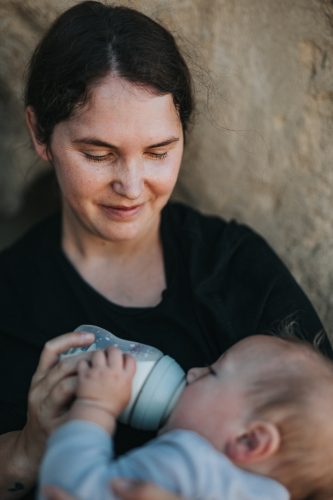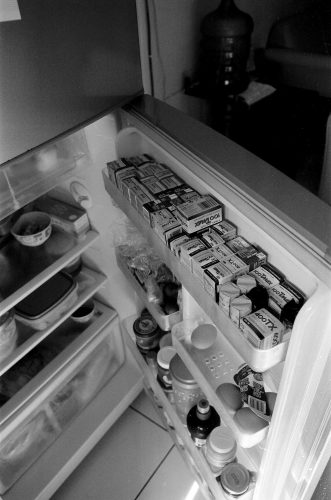If you’ve been pumping for a while, you likely know the worries associated with serving your little one with breast milk that could potentially be contaminated. But what about the question, “Why can’t you add warm breast milk to cold?” Is there a reason you shouldn’t do it, and if so, what are some ways around it? We will answer all of that and more in today’s post.
Can You Add Warm Breastmilk to Refrigerated Breastmilk?
Yes, you can! But there are some cases in which you can’t.
Confusing? Let us explain.
Combining cold breast milk to warm breast milk isn’t in and of itself inherently bad. If you plan to feed your baby right away and the chilled breastmilk is still fresh, then you can safely combine it with your warm, freshly pumped breast milk. Be sure, however, to warm the entirety of the milk (both warm and chilled once combined) by your method of choice, to provide a unified warm temperature. This will discourage the growth of bacteria, as the bottle becomes one temperature before being fed to your baby.
So, why so many warnings against combining warm and cold breast milk? Mixing warm and cold breast milk can cause problems when the two are combined and placed in the refrigerator. It is here that warm and cold breast milk can breed bacteria, as the two different temperatures provide an environment that is conducive to the growth of germs. This is also true when combining warm and cold breast milk and allowing them to sit at room temperature unused. When doing this, the risk can be even greater if the bottle isn’t fed to your baby right away.

Why Can’t You Add Room Temperature Breast Milk to Refrigerated?
Bacteria growth is the main reason you don’t typically want to combine room temperature or warm breast milk with chilled breast milk. But sometimes even this isn’t enough to thwart some mamas from trying it anyway.
Whether you are drinking oat milk for breast milk supply or are trying body armor breastfeeding, you likely want to combine and feed your baby all the breast milk– you can as efficiently as you can. And sometimes that involves combining warm and chilled milk.
We get it! But because babies have immature immune systems, they get sick much quicker when exposed to germs and bacteria. Thus, it is important that you forgo mixing your freshly expressed breast milk with the chilled breast milk you’ve stored in your refrigerator.
Remember that you may combine both warm and cold breast milk if you plan to feed it right away, but that you must warm the bottle before doing so. Consider ordering a bottle warmer to do this, as this will make the process much easier and safer.
Microwaving your baby’s bottle, though a popular option, isn’t recommended, because it can cause “hot spots” in your baby’s bottle as the liquid begins to warm unevenly.
Can I Add Fresh Breast Milk to Room Temperature Milk?
We suppose you could mix room temperature breast milk with fresh breast milk, but now the question becomes how long did the room temperature breast milk sit out?
You can safely leave your breast milk sitting out for 4-6 hours, but be very careful. If it is particularly hot in your home or if the breast milk smells or looks off, be sure not to use it.
Note that separation of fats is to be expected. Simply stir the milk or shake the bottle to evenly redistribute the milk fat.
As long as your breast milk has been sitting at room temperature for no longer than 4-6 hours, you should be fine mixing your freshly expressed breast milk with the room temperature milk. Otherwise, you’ll want to place the breast milk in the fridge, label it with the date, and keep it there for 4 hours.
Can You Mix Breast Milk?
Can I Mix Left and Right Breast Milk?
Yes, it is possible to mix right and left breast milk, providing that the two are of the same temperature, or if they aren’t the same temperature, that you mix and feed them to your baby immediately after warming the bottle.
In order to add chilled breast milk to freshly expressed breast milk safely to later be consumed by your baby, you’ll first need to chill both milks. Breast milk that has already been in the fridge will already be cooled. But freshly expressed milk will also need to spend a couple of hours in the fridge to become cool before you can combine the two.
Some women find that combining breast milk in a pitcher is a great way to store breast milk throughout the day.
To do this, you’ll want to grab a pitcher and ensure that it is clean. As you pump throughout the day, store your freshly expressed milk in the fridge in the bottle you’ve pumped into until your next pumping session.
At your next pumping session, retrieve the milk from your first pumping session and dump it in the pitcher. At this point, the milk will have already cooled. Store the milk from your current pumping session in the refrigerator and repeat the process over again.
At your next pumping session, you’ll dump your previously pumped milk into the pitcher and so forth. It can help to draw lines on your pitcher to indicate feed/bottle amounts dumped. This way you can track how much milk you need to pour and how much milk is left over once you begin to use the chilled milk in the pitcher.
The pitcher method is a great way to make more room in the fridge. This method can be used for milk pumped from both breasts. Just be sure to label the milk with the date of the very first pump. Use all of the milk after 4 days have passed from that date.

Can You Mix Thawed Breast Milk From Different Days?
You can mix thawed breast milk from different days. But you’ll need to make sure to go by the date of the oldest breast milk expressed. This is particularly important when combining chilled milk that hasn’t yet been frozen. Going by the date of the fresher milk may cause your baby to ingest spoiled milk which may make your baby sick.
In addition, you’ll want to make sure you thaw out breast milk the correct way–in the refrigerator. Be sure never to refreeze breast milk after thawing.
Again, never refreeze thawed breast milk at room temperature.
Bottles that have been thawed in the fridge are good to remain in the fridge for 24 hours after the milk has completely thawed out.
Can You Mix Breast Milk From Different Days?
Yes, you can, but always ensure that:
- Both types of breast milk are chilled, brought to room temperature, or are warmed for immediate feeding. Do not store warm breast milk with cold breast milk in the refrigerator. Also, don’t allow the two milks of differing temperatures to sit at room temperature without being placed in a bottle warmer
- You go by the date of the oldest breast milk, rather than the newest. This will ensure the freshest breast milk for your baby.
- Make sure that neither breast milk, but especially the oldest milk, has not gone rancid. Sniff it and check the consistency to ensure it is still safe for consumption before mixing it with another milk.
| Breast Milk Temperature | Amount of Time Breast Milk Stays Fresh |
| Chilled | 24 hours Thawed and Chilled/ 4 Days Chilled Continuously |
| Room Temperature | 4-6 Hours |
| Frozen | 6 to 12 Months |
Can You Combine Breast Milk From the Same Day?
Yes, you can combine breast milk from the same day, and actually, it is recommended.
Combining breast milk from the same day ensures that the breast milk has the freshest taste. However, you will still want to follow the aforementioned protocol for mixing warm and cold breast milk to forgo cultivating bacteria within your baby’s bottle, even if the milk is from the same day.
What Happens If Baby Drinks Spoiled Breast Milk?
If you feed your baby spoiled breast milk, he or she is likely to:
- throw up
- have diarrhea
- experience other gastric issues
If you notice that your baby is acting differently, develops a fever, or displays other concerning signs of being seriously ill, we recommend you call your pediatrician to find out what the next best course of action would be.
Follow the instructions in the table listed above for recommendations on the time frames at which you should store your breast milk to keep your baby healthy and safe.
Mixing Warm and Cold Breast Milk Can Be Done: Carefully!
All in all, it is important to remember that while you technically can combine warm and cold breast milk if it is going to be fed to your baby immediately, you should still do so with caution.
Remember to place the bottle in a bottle warmer before serving to your baby if you choose to do so. Never combine warm and cold breast milk to be placed in the fridge. It is in this scenario that bacteria growth may happen.
Follow the aforementioned steps for properly and safely storing breast milk to keep your baby safe.
Lynn
Lynn is a freelance writer, a wife, and a mother of two beautiful kids. Lynn started Infant Empire with the aim of making parenting easier for fellow mums and dads. She believes the parenting tips provided here will be of great help to all parents.Recommended Reading
When to Stop Using Dr. Brown Vent Bottles
We’ll answer exactly a few frequently asked questions involving Dr. Brown’s popular anti-colic venting system bottles.
Does Cold Formula Cause Gas?
Like so many things related to your baby, whether or not to feed your baby warm or chilled milk is debatable.
5 Best Sterilizers for Comotomo Bottles (How To Clean & Sterilize) 2022
In this guide, we look at how to sterilize comotomo bottles using a sterilizer and also review the best sterilizer for comotomo bottles
How to Warm Breast Milk on the Go
Whether you’re at the store, a restaurant, or at a relative's house, there are ways that you can manage to warm your baby’s breast milk.
How To Get A Deeper Latch When Breastfeeding: Inverted Nipples Solution (2022)
New moms with inverted or flat nipples may have a hard time getting a deeper latch when breastfeeding since they may experience soreness and pain.


Leave a Reply